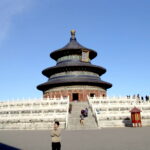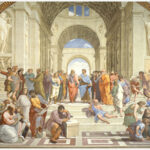The Reductionist West and Ancient Wisdom
Modern science tells us that what we can truly say about empirical reality only has relative (Relativity) or statistical significance (Quantum Mechanics), Quantum Theory in particular calling into question the role of the observer[1] but each of these disciplines resting on epistemological grounds that identify the boundaries of reality by static observable phenomena that can be brought out by repeated experiment, i.e. what the scientific community refers to as verifiable results. This epistemological position, although very rarely explicitly called out as such, is the essence of the empiricist view of reality and this in turn has the side effect of isolating and quarantining all other phenomena as “unscientific”, or simply “subjective”, hence the more and more common assertion that theological and philosophical inquiry is for those who are unscientifically minded.
The problem with this approach however is that it is very rarely pointed out what the epistemological assumptions are in fact in order that this for this scientific approach to represent “truth”. Nor is it made clear where the boundaries of this Truth lay, it is simply presumed that anything that lay outside this domain is a matter of the humanities and is subjective, effectively outside the domain of natural philosophy as Aristotle carved out the domains of reality so many centuries ago.
The path to this intellectual destination that we find ourselves in today was a long one but it no doubt started with the Greek/Hellenic philosophical tradition. It then evolved very closely together with our understanding of the universe itself at the macroscopic scale as we came to understand that the Earth revolved around the Sun and that for all intents and purposes the “observable” universe emerged from a singularity event some 14 billion years ago, leaving us with unwavering faith in mathematics along with its cause and effect, materialistic and deterministic view of reality as the Worldview. This is physical reality and while the “psychological” domain remains integral to any sort of perception, “I think therefore I am”, this essential philosophical pillar is left out of virtually all modern day scientific discussions. Quantum Mechanics however brings this basic truth right back into the forefront of the conversation about the nature of reality. And yet physicists have turned to what can only be called “nonsensical” explanations (multi-dimensional reality for example) to explain away this strange and odd phenomena that reveals itself in the subatomic world, speaking to our blind faith in mathematics as the only truth that can be relied on unequivocally and our stubborn reluctance to admit the role that cognitive perception plays in any universal model we create.
The problem with this is that based upon our human experience, our psyche is the dominating force of each and every individual’s reality. The fact that a table can be said to exist, that it has specific dimensions and has a specific molecular structure that can be described precisely, that it can be said to have a specific weight and specific height, that it can be said to exist in a certain time and space, that it can be said to obey certain laws of radioactive decay is all well and good, and extraordinarily powerful when it comes to technological advancement (and underpins the Information Age and scientific evolution in the last few centuries) but it says absolutely nothing about the purpose of the table – why it exists – nor does it say anything about and how the experience of perceiving the table fits into our existence as individuals and how that experience can be shaped to improve our way of life as well as the underlying social fabric of society. This latter questions remains the fundamental topic of the philosophers of antiquity and is almost complete absent of academic and scientific, and even religious, dialogue today.
Why this table exists, and the role of “purpose” in defining the reality of anything that can be said to exist is called teleology in philosophic circles and this was a prime element of Aristotle’s causal model on top of which his epistemology sat, a model that has been abandoned for the most part in modern scientific parlance to the point where the standard interpretation of Quantum Mechanics, the one that is taught in most if not all academic institutions, is that the math is what the math is, it’s a calculation tool and nothing can or should be said about what it tells us about the reality of the world we live in (Copenhagen Interpretation).
And arguably what’s worse, is that there are many who have interpreted the mechanical theory to imply, in as a deterministic and materialistic a view as possible, that the stochastic (statistical) nature of the math indicates not that there is a higher order principle at work as Bohm proposed with his notion of the implicate order, but that each of the potential outcomes represents a reality in and of itself that actually exists in the real, empirical sense. This the multi-verse interpretation of Quantum Mechanics that seems to be gaining so much ground in the physics (and popular science) community today that although aligns with the underlying mathematics quite nicely completely goes against any shred of common sense.
The theory’s original author, Hugh Everett, postulated in a thesis dissertation that the wave mechanics underling quantum mechanics is reflective of the observer being an integral aspect of, and participating agent in, measurement phenomena. This “Relative State” could be said to exist – but only in the theoretical, transcendental reality sense, rather than the wavefunction potential paths themselves having a real existence independent of observation. What this Multi-Verse Interpretation does reflect however, which is somewhat alarming, is a resounding and unwavering faith in determinism and local realism, even if it defies any sense of what we perceive to be “real” from a human cognitive perspective. We’ve effectively left the reservation on this one.
But what’s been lost in all of this empiricist obsession is that there is another way to look at the world that is not entirely reductionist, and that in this changing of perspective a different kind of knowledge, what Jung called “absolute knowledge” in his treatise on synchronicity that he wrote in collaboration with physicist Wolfgang Pauli, the author of the “exclusion principle”. This more broad definition of knowledge has a long standing tradition, longstanding in the West with the Platonists and Stoics and even some of the pre-Socratics and long standing in the East in the Taoist, Vedic and Buddhist theo-philosophical schools which are fundamentally non-reductionist and incorporate the reality of, and interconnectedness of the, psychological domain directly into their theo-philosophical systems, their metaphysics as it were.
In studying the worldview and mindset of the ancients, specifically the first philosophical systems that were invented in antiquity, one cannot help oneself in asking the fundamental question why one is interested in, and what in fact we can learn, by studying these ancient belief systems. Most certainly one can argue that by understanding our history, not just as a civilization but as a race in toto, one can come to a better understanding of ourselves as a race in our modern, world integrated society that we live in today. But is there something more than that?
Many scientists and academics today no doubt consider the study of ancient systems of belief interesting in their own right, and illustrative of how life was some three to four thousand years ago when civilization as we know it today first takes root in the Indus valley region, the Tigres-Euphrates delta, in Northern Africa/Egypt on the banks of the Nile, in the Mediterranean and then to the far east in modern China – all incidentally at around the same time give or take a few hundred years[2]. But also it appears that many in academia, specifically in the more hard scientific fields (Engineering, Physics, etc.) write off much of the knowledge of these ancient peoples as outdated, misinformed and while interesting from a mythological or historical perspective not very applicable to modern times where the great pillars of modern Science prevail. In no small measure this notion, this camp of Scientific believers as it were, digs into their blind faith of empirical, substantive reality to counteract the blind faith and irrational beliefs surrounding Religion, the presumed source of much of the world’s conflict in our modern era.
But what if perhaps in looking into the mind of the ancients, in trying to understand and peel back the layers of dust and dogma that rest on top of the of ancient texts as they have been discovered in finds across the world, that there is some ancient wisdom there that has in fact been lost, that can in fact be “re-discovered” if only the texts, the words, and their context are but looked at and understood with the proper lens? For there is no doubt some truth to the adage that for everything gained there is something lost, and given how much we have indeed gained in the last two thousand years we must have undoubtedly lost something along the way.
It is this belief – and there is an element of faith here no doubt – that as we have progressed in so many different ways in the modern era to be able to support the massive global society that we live in today, that we have lost our connection to the world we live in, and its fundamental source and essence, that it has been shrouded in layers and layers of specialized commoditization of goods and services and that our connection with each other has in fact been lost along with it, having been wrapped, warped and bastardized from a deep rooted spiritual connection to a transaction with some sort of mutual benefit in mind. With the rise of consumerism and capitalism that so fuels now almost the entire civilized world, we have seen also a significant rise in what we have termed “religious extremism” which at some level no doubt is fueled by an equal and opposite reaction to these very same forces. While at the very top of these movements there exists a quest for wealth and power consistent with all of the great world conflicts we have seen throughout the ages but at their core there is something else going on. These movements would not be able to take root if there was not fertile ground for them to yield fruit and there does exist a level of disenfranchisement, dissatisfaction and even abhorrence with the values and principles upon which the West conducts itself which helps to give rise to these extremist and violent factions that have gained such prominence in the last few decades. One only must listen to the dark rhetoric coming from some of the senior officials in Iran, or ISIS, to get a taste of this and while we might be quick to write off these statements and behavior as simply “evil” that must be “vanquished”, this type of simplistic thinking is just how we found ourselves in the current geopolitical mess we are in today.
This is not to suggest that there is some utopial based ancient society that we should strive to bring back to life in some way, where everyone was happy and “enlightened”, but it does beg the very interesting question that perhaps, just maybe, there exists a thread and undercurrent of knowledge reflected in the teachings of the of the great sages of old from antiquity – the Buddha’s, the Laotzu’s, the Christ’s, the Socrates’s … – that harkens back to a time when we were connected to the world around us in a more direct and fundamental way, when everything was sacred more or less, and when there existed a much more direct, open and more well understood connection with the divine even if it could not be revealed in a scientific experiment.
In studying the wisdom of the ancients to the West (the Greeks and Romans primarily but to a lesser extent this includes the wisdom of the Sumer-Babylonians, Egyptians, Persians and Arabs as well which was incorporated into this wisdom tree essentially) we have what might be called a direct line of sight view into the progression and advancement of knowledge. While there are certainly gaps in terms of extant works, etc. what we do have with this tradition is the inheritance of the very language, both written and spoken, from these ancient peoples. For how we speak today, and how we write, in the West in the Indo-European dialects and in all of the major alphabets and writing systems that are in use, are for the most part direct descendants of the languages that these ancient peoples spoke and wrote in. This is even true of the languages spoken and written in ancient India – Sanskrit. This whole system of knowledge can be linearly mapped in a certain way to how we think, how we understand the world around us, and of course how we communicate with each other.
This is of course facilitated by the tremendous scholarship and intellectual integration work that has been done by countless scholars in the last hundred years or so that have painstaking reviewed, dated, and translated ancient works from all of these disparate ancient civilizations, aided again by the advent of mass, world communications, the digitization and wide availability of content like the world has never seen. What results is a looking glass into the mind of these ancient peoples, these ancient authors really, that is relatively clear. There are questions, doubts, uncertainties that remain in interpreting all of these ancient works no doubt, and scholars and academics will debate these nuances in decades to come, but there is widespread agreed upon perspective on what these ancient authors were trying to convey, and what these ideas and notions “mean” in our modern tongues and intellectual frameworks that allows us to truly “understand” (for the most part) the essence of many if not all of these ancient works from all of these varying different ancient civilizations.
As we go further East however, we find a natural physical boundary – the Himalayas – that allowed for the almost completely independent development of civilization that runs in some respects almost eerily parallel to the development of civilization and thought in the West. This on the one hand provides for a study of intellectual and societal development in antiquity that can be compared and contrasted directly to its counterparts in the West, a comparative study that yields no doubt a better understanding of each of the intellectual frameworks or worldviews. But one encounters different challenges when one crosses this great boundary in antiquity, mainly that the tools that were used and developed to communicate, language, although shared some of the same characteristics as the tools to the West, were nonetheless different enough that trying to map ideas and concepts from our modern tongues back to their ancient systems of belief yields unique challenges that we do not find when studying the ancient civilizations in the West which are our direct forefathers basically.
What we are speaking of here specifically of course is the language, specifically the written language, that was used by the ancient Chinese and what impact that system of communication has on our ability – our ability in the West – to understand the minds of the ancient Chinese intellectuals, to map their worldview and metaphysical constructs into proper Western concepts (if possible), to compare these ancient intellectual developments with what occurred to the West, in the Mediterranean primarily, and maybe perhaps come to a better understanding of the worldview of our Eastern neighbors today. For their language evolved symbiotically with their culture and vice versa.
[1] See Snow Cone Diaries, “Death of Local Realism” chapter for a review of the two theories and their fundamental limitations.
[2] Sometimes referred to as the “Axial Age”.




Leave a Reply
Want to join the discussion?Feel free to contribute!